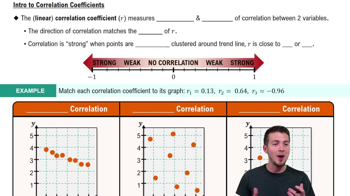Here are the essential concepts you must grasp in order to answer the question correctly.
Causation vs. Correlation
Causation refers to a direct cause-and-effect relationship between two variables, while correlation indicates a relationship where two variables change together but do not necessarily influence each other. In this context, while the study shows a correlation between exercise and T cell production, it does not definitively prove that exercise causes increased T cell production.
Recommended video:
Control Groups
Control groups are essential in experimental studies as they provide a baseline for comparison. In this study, senior citizens who do not exercise serve as a control group, allowing researchers to assess the impact of exercise on T cell production. Without a control group, it would be challenging to determine whether the observed effects are due to exercise or other factors.
Recommended video:
Creating Scatterplots - Graphing Calculator
Statistical Significance
Statistical significance helps determine whether the results of a study are likely due to chance or represent a true effect. In this study, the significant difference in T cell production between exercising and non-exercising seniors suggests that exercise may have an impact, but further research is needed to establish a causal link and rule out confounding variables.
Recommended video:
Parameters vs. Statistics
 Verified step by step guidance
Verified step by step guidance Verified video answer for a similar problem:
Verified video answer for a similar problem:



 2:13m
2:13m